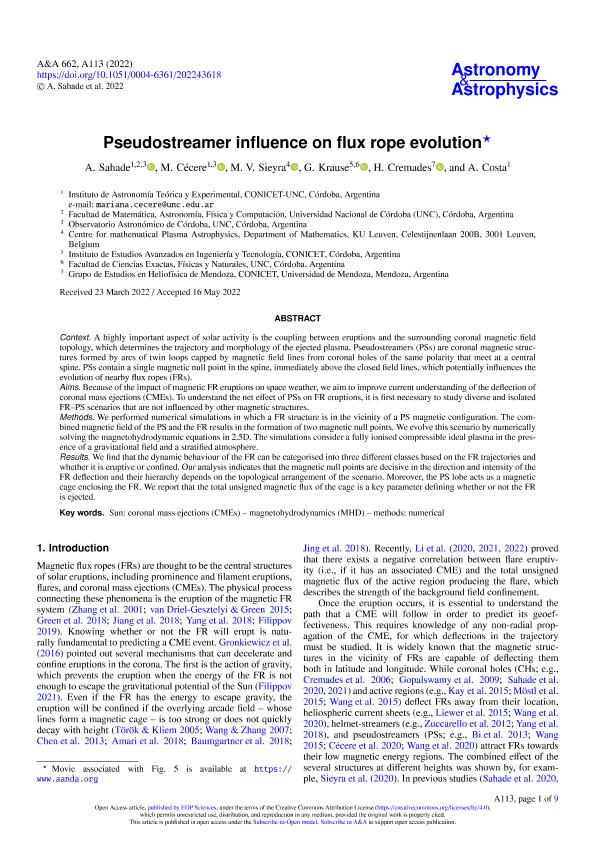Mostrar el registro sencillo del ítem
dc.contributor.author
Sahade, Abril

dc.contributor.author
Cécere, Mariana Andrea

dc.contributor.author
Sieyra, María Valeria

dc.contributor.author
Krause, Gustavo Javier

dc.contributor.author
Cremades Fernandez, Maria Hebe

dc.contributor.author
Costa, Andrea

dc.date.available
2023-07-10T19:01:54Z
dc.date.issued
2022-06
dc.identifier.citation
Sahade, Abril; Cécere, Mariana Andrea; Sieyra, María Valeria; Krause, Gustavo Javier; Cremades Fernandez, Maria Hebe; et al.; Pseudostreamer influence on flux rope evolution; EDP Sciences; Astronomy and Astrophysics; 662; A113; 6-2022; 1-9
dc.identifier.issn
0004-6361
dc.identifier.uri
http://hdl.handle.net/11336/203077
dc.description.abstract
Context. A highly important aspect of solar activity is the coupling between eruptions and the surrounding coronal magnetic field topology, which determines the trajectory and morphology of the ejected plasma. Pseudostreamers (PSs) are coronal magnetic structures formed by arcs of twin loops capped by magnetic field lines from coronal holes of the same polarity that meet at a central spine. PSs contain a single magnetic null point in the spine, immediately above the closed field lines, which potentially influences the evolution of nearby flux ropes (FRs). Aims. Because of the impact of magnetic FR eruptions on space weather, we aim to improve current understanding of the deflection of coronal mass ejections (CMEs). To understand the net effect of PSs on FR eruptions, it is first necessary to study diverse and isolated-PS scenarios that are not influenced by other magnetic structures. Methods. We performed numerical simulations in which a FR structure is in the vicinity of a PS magnetic configuration. The combined magnetic field of the PS and the FR results in the formation of two magnetic null points. We evolve this scenario by numerically solving the magnetohydrodynamic equations in 2.5D. The simulations consider a fully ionised compressible ideal plasma in the presence of a gravitational field and a stratified atmosphere. Results. We find that the dynamic behaviour of the FR can be categorised into three different classes based on the FR trajectories and whether it is eruptive or confined. Our analysis indicates that the magnetic null points are decisive in the direction and intensity of the FR deflection and their hierarchy depends on the topological arrangement of the scenario. Moreover, the PS lobe acts as a magnetic cage enclosing the FR. We report that the total unsigned magnetic flux of the cage is a key parameter defining whether or not the FR is ejected.
dc.format
application/pdf
dc.language.iso
eng
dc.publisher
EDP Sciences

dc.rights
info:eu-repo/semantics/openAccess
dc.rights.uri
https://creativecommons.org/licenses/by/2.5/ar/
dc.subject
MAGNETOHYDRODYNAMICS (MHD)
dc.subject
METHODS: NUMERICAL
dc.subject
SUN: CORONAL MASS EJECTIONS (CMES)
dc.subject.classification
Astronomía

dc.subject.classification
Ciencias Físicas

dc.subject.classification
CIENCIAS NATURALES Y EXACTAS

dc.title
Pseudostreamer influence on flux rope evolution
dc.type
info:eu-repo/semantics/article
dc.type
info:ar-repo/semantics/artículo
dc.type
info:eu-repo/semantics/publishedVersion
dc.date.updated
2023-07-06T11:21:41Z
dc.journal.volume
662
dc.journal.number
A113
dc.journal.pagination
1-9
dc.journal.pais
Francia

dc.journal.ciudad
París
dc.description.fil
Fil: Sahade, Abril. Consejo Nacional de Investigaciones Científicas y Técnicas. Centro Científico Tecnológico Conicet - Córdoba. Instituto de Astronomía Teórica y Experimental. Universidad Nacional de Córdoba. Observatorio Astronómico de Córdoba. Instituto de Astronomía Teórica y Experimental; Argentina. Universidad Nacional de Córdoba. Observatorio Astronómico de Córdoba; Argentina
dc.description.fil
Fil: Cécere, Mariana Andrea. Consejo Nacional de Investigaciones Científicas y Técnicas. Centro Científico Tecnológico Conicet - Córdoba. Instituto de Astronomía Teórica y Experimental. Universidad Nacional de Córdoba. Observatorio Astronómico de Córdoba. Instituto de Astronomía Teórica y Experimental; Argentina. Universidad Nacional de Córdoba. Observatorio Astronómico de Córdoba; Argentina
dc.description.fil
Fil: Sieyra, María Valeria. Consejo Nacional de Investigaciones Científicas y Técnicas. Centro Científico Tecnológico Conicet - Córdoba. Instituto de Astronomía Teórica y Experimental. Universidad Nacional de Córdoba. Observatorio Astronómico de Córdoba. Instituto de Astronomía Teórica y Experimental; Argentina. Katholikie Universiteit Leuven; Bélgica
dc.description.fil
Fil: Krause, Gustavo Javier. Consejo Nacional de Investigaciones Científicas y Técnicas; Argentina. Universidad Nacional de Córdoba; Argentina
dc.description.fil
Fil: Cremades Fernandez, Maria Hebe. Consejo Nacional de Investigaciones Científicas y Técnicas; Argentina. Universidad de Mendoza; Argentina
dc.description.fil
Fil: Costa, Andrea. Consejo Nacional de Investigaciones Científicas y Técnicas. Centro Científico Tecnológico Conicet - Córdoba. Instituto de Astronomía Teórica y Experimental. Universidad Nacional de Córdoba. Observatorio Astronómico de Córdoba. Instituto de Astronomía Teórica y Experimental; Argentina
dc.journal.title
Astronomy and Astrophysics

dc.relation.alternativeid
info:eu-repo/semantics/altIdentifier/doi/http://dx.doi.org/10.1051/0004-6361/202243618
dc.relation.alternativeid
info:eu-repo/semantics/altIdentifier/url/https://www.aanda.org/articles/aa/full_html/2022/06/aa43618-22/aa43618-22.html
Archivos asociados
